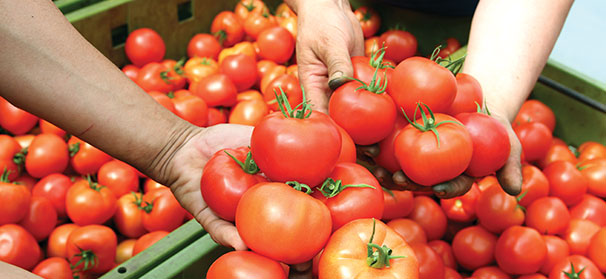

Oct 16, 2014Food safety starts with washing your hands
The most important food safety measure in processing plants, fields and orchards may also be the simplest: wash your hands.
All too often, those hands serve as a pathway to future trouble.
FDA estimates 3.1 million illnesses a year are attributable to produce, with 31 percent of the likelihood of contamination due to the health and hygiene of the produce worker. FDA also noted that 91 percent of farm workers do not wash their hands before work, 25 percent do not wash their hands after using the toilet and 30 percent of workers that reported use of a toilet that was provided said they went to the bathroom in the field.
Then there are the other microbes in the soil that can pose threats to food safety. There is an effort underway to conduct more research on how the microbes interact with soils and in turn with soap and alcohol-based hand sanitizers.
“Hands are generally more soiled in agriculture than they are in other industries, so we’re trying to understand how effective is alcohol on visibly soiled hands,” said Dave Shumaker, a microbiologist for GOJO Industries, a producer of skin health and hygiene products.
As a company that specializes in cleaning, washing and sanitizing of hands, GOJO studied the hand hygiene recommendations contained in the initial Food Safety Modernization Act (FSMA) produce safety rule (a revised set of rules was recently released).
In the company’s comments, it advocated a “situational approach” to hand hygiene in produce handling, including:
Hand washing with soap and water at critical moments, identified when hands are visibly soiled
The use of hand washing with soap and water or the use of an alcohol-based hand sanitizer when hands are not visibly soiled
The use of an alcohol-based hand sanitizer (single or multiple use regimens) in certain situations where adequate soap and water may not be practical or available
The proposed rule acknowledges the quantity of soap and water, the duration of scrubbing and rinsing and whether the hands are dried. GOJO’s comments noted that another set of efficiency variables were not acknowledged, including the quality of the soap, the presence or absence of antimicrobials and whether or not a fingernail brush is used.
“There were really no standards about how effective soap and water or hand sanitizers need to be,” Shumaker said. “If hand hygiene is so important, it is important to do it well.”
GOJO is collaborating on a pair of projects to better understand how sanitizers and soaps interact with the presence of organic materials in soils. Researchers from Emory University and Universidad Autonoma de Nuevo Leon, Mexico, are assessing the effectiveness of different hand hygiene interventions on the farm, including alcohol-based and bland soap products. The research projects are examining the conditions present on farms.
“We’re trying to answer the question, ‘are unique hand hygiene solutions necessary for this unique environment?’ The farm does provide different challenges. There are different levels of organic material the worker encounters throughout the day,” Shumaker said.
These organic materials should not be thought of only as “dirt” or “soil.” The issue of most concern may actually be organic material from the plant and how to remove it. Researchers are looking at the effective levels of “rinse-off” and “leave-on” soaps and hand sanitizers.
“It’s really a different type of soil than you’d think. It’s more the kind of a gooey plant material from each individual crop that you’ll find,” Shumaker said. “One point we’re trying to get across is that the focus has been in removing soil or organic material off workers’ hands, but it really should be on making hands safe. A visibly clean hand may not be a safe hand.”
The proposed FSMA rule describes times when workers should wash hands thoroughly. They include before starting work, before putting on gloves, after using the toilet, when returning from break or other absence, as soon as possible after touching animals or animal waste and “at any other time when the hands may have become contaminated in a manner that is reasonably likely to lead to contamination of covered produce with known or reasonably foreseeable hazards.”
Problems caused in the field by poor hand hygiene can migrate into the processing plant, which has some challenges of its own in regard to hand hygiene. One of them is the type of dispenser used. Many companies advocate the use of non-fillable dispensers rather than bulk dispensers, which present some sanitation concerns, Shumaker said. The same issue exists with bulk soap dispensers in the field.
“Lids come loose and germs can easily get into soap dispensers. Biofilms form on the inside of the dispenser. You can’t even clean them with bleach” he said. “Health care and other industries understand this, but the food industry has yet to be totally aware of this issue.”
The governing principle for produce processing plants is that hand hygiene solutions should be made available and accessible in ways that would encourage workers to want to use them.
Other general principles for in-plant use of hand sanitizers mentioned by Shumaker include:
Make sure soap dispensers are available and that they are full
Consider the use of touch-free dispensers. People are more likely to use this kind of dispenser than a manual-push model
Institute a culture of hand hygiene, and make sure supervisors don’t ignore it
Use proper signage
Have products the workers like. “If you don’t have good compliance, then you don’t have good efficacy, even if the product is a good formulation”
Most of the information about how well a hand-sanitizing product works will come from the manufacturer, Shumaker said. The sanitizer companies should have tested each product for its efficacy against pathogens (including the major organisms of concern like E. coli and salmonella) and be able to present their data.
– Lee Dean














